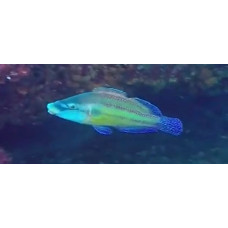Latin name
Symphodus tinca
Other names
Symphodus tinca
Identification
The body is oval and flattened at the sides. The mouth is rather small, more or less protruding, with rather strong fangs. There are several head pores on the muzzle; lips with 6-9 wrinkles. The head is generally longer than the depth of the body. The dorsal fin is very long, reaching almost to the tail. Both sexes have a small dark spot at the base of the caudal fin and a dark spot just above the pectoral fin. There are also many dark spots on the body, forming 3 or 4 longitudinal stripes. Colouration usually reflects sexual dimorphism. Females and juveniles are grey-greenish or brownish, becoming silvery on the belly. There is little difference in colouration between immature males and mature females. Males are more brightly coloured, especially during the breeding season. They are pale green, green-blue or green-yellow, with longitudinal rows of red spots, the top of the head is dark blue.
Distribution
It inhabits the Mediterranean Sea and adjacent waters of the Atlantic Ocean (from the Bay of Biscay to Morocco), the Marmara and Black Seas, and the Kerch Strait.
Habitat
This gregarious coastal fish is found on rocky reefs covered with seaweed, on seagrass beds, around rocks surrounded by seaweed and can also be found in the brackish waters of lagoons. It is found at depths from 1 to 50 m (3.3 to 164.0 ft).
Size
Can grow to 44 cm (17 inches) in length, although most do not exceed 25 cm (9.8 inches). Weighs up to 290g.
Life history and Behavior
Spawning occurs in spring. Nests are made of seaweed and are round or oval in shape, 10-20 cm in diameter. Several females lay eggs in one nest, while the males guard the clutches. Life expectancy is up to 14-15 years.
Food and feeding habits
Feeds on sea urchins, brittle stars, mussels, shrimps and crabs.
Reproduction
Spawns in April-May, laying round eggs on algae and other underwater vegetation. Fecundity of females 175-260 mm long is 12300-57800 eggs. Eggs, as in other species of the genus, are benthic and hatch in several, 3-4 portions. Embryonic development lasts 121-200 hours at temperatures close to natural conditions, in the Mediterranean it is twice as short - 4 days.
Interesting Facts
Thanks to the structure of the muscles around their swim bladder, the East Atlantic peacock wrasse can produce low-tonal sounds. However, the purpose of this ability is not yet understood.
Fish that eat bottom-dwelling creatures usually use both sight and smell to find their food. But the East Atlantic peacock wrasse, which feeds on shellfish, uses sight alone. If this fish goes blind, it will die because it has no chance of finding a mussel shell without its eyes.
| Classification | |
| Phylum | Chordata |
| Class | Actinopterygii |
| Squad | Gadiformes |
| Family | Merlucciidae |
| Genus | Merluccius |
| Species | M. merluccius |
| Features | |
| Conservation status | Least Concern |
| Habitat | Littoral |
| Life span, years | 20 |
| Maximum body weight, kg | 15 |
| Maximum length, cm | 44 |
| Sailing speed, m/s | No information |
| Threat to people | Edible |
| Way of eating | Predator |



